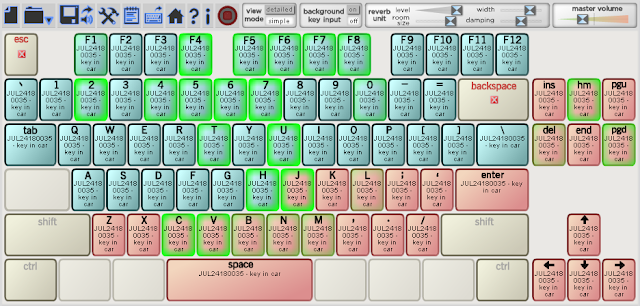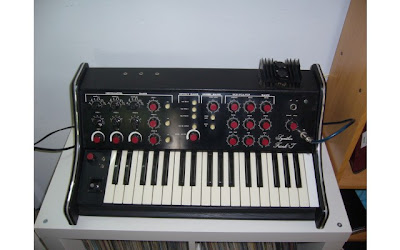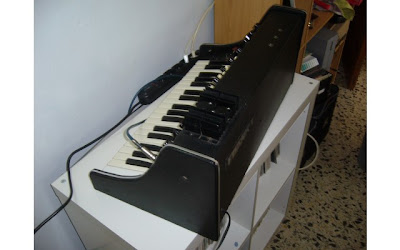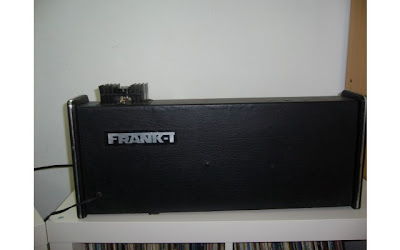 "Soundplant 39 Released – Turns The QWERTY Keyboard Into A Playable Instrument & Instant Sound Triggering Tool
"Soundplant 39 Released – Turns The QWERTY Keyboard Into A Playable Instrument & Instant Sound Triggering ToolNew York, NY – May 20, 2010 – Today Marcel Blum released Soundplant 39 for Windows and Mac, the first major update since 2004 of the popular low cost software sampler that turns the computer keyboard into a low latency digital audio performance tool and playable instrument. Ultra-optimized for the standard QWERTY keyboard, Soundplant allows the assignment of sound files of unlimited size onto 72 keyboard keys, for hours of instantly-playing audio with no need for extra hardware.
New version 39 adds several major features in response to user requests, including support for virtually all audio file formats in existence, a 'background key detection' mode that allows Soundplant to continue receiving key input even while minimized or hidden, waveform display, detailed playback progress indicators for all channels, precise fading control, and randomization settings. Soundplant 39 also marks the first official Mac release after several years in beta on that platform.
Since it’s debut as a free Windows beta in 1999, Soundplant has won multiple awards and gained a dedicated cult following in the DJ and pro audio worlds for its combination of simplicity, standalone sound triggering power, rock-solid stability for live use, low cost, and versatility as a multipurpose playback utility. The BBC uses it for sound design on Doctor Who. Breakcore producer Droon uses it during his raucous performances with a keyboard strapped around his neck like a QWERTY keytar. When John McCain won primaries during his 2008 presidential campaign, it was Soundplant playing "Johnny B. Goode" at his victory rallies. Electroacoustic composer Darren Copeland even created a composition for Soundplant (Letters To Our Names, for 1 or more laptop performers). Soundplant’s spread by word of mouth has been viral, with the $35 software challenging - and in some spheres overtaking - the dominance of expensive dedicated hardware; in Sweden, sound engineer Mattias Dalin of SVT calls Soundplant "without doubt the most used playback program in TV work over here, with great success."
 Soundplant can be used to trigger sound effects or background tracks during a show, for music or loop creation, as a drum pad, as an educational aid, as a unique electronic instrument with an input device you’ve been practicing on for as long as you’ve been typing, and as a sound design sketchpad. It allows dragging and dropping sound files on to keys for quick and easy setup; playback from RAM for instant cueing or from disk for unlimited sound length; auto-pitch-assign to easily spread the same sound across multiple keys at varying pitches; auto-offset-assign to quickly slice up samples across multiple keys; and much more. Soundplant is a true performance program that allows playback and triggering to continue even while configuring, loading, and unloading sounds on the fly.
Soundplant can be used to trigger sound effects or background tracks during a show, for music or loop creation, as a drum pad, as an educational aid, as a unique electronic instrument with an input device you’ve been practicing on for as long as you’ve been typing, and as a sound design sketchpad. It allows dragging and dropping sound files on to keys for quick and easy setup; playback from RAM for instant cueing or from disk for unlimited sound length; auto-pitch-assign to easily spread the same sound across multiple keys at varying pitches; auto-offset-assign to quickly slice up samples across multiple keys; and much more. Soundplant is a true performance program that allows playback and triggering to continue even while configuring, loading, and unloading sounds on the fly.Availability and pricing
Soundplant is offered as a free download at http://soundplant.org/ which includes a 25-launch trial of the registered features. In unregistered mode it is free for non-commercial use and limited to playing uncompressed 8- and 16-bit wav and aif files. The registered version (USD $35, or a $27 upgrade from previous versions) allows loading all sound file types including higher bit depths, compressed formats like mp3, mp4, flac, wma, alac, audio from video files like avi, flv, mov, wmv, and more.
About the author
Marcel Blum is an independent software developer, musician, and vinyl archaeologist based in New York City. As a programmer, he develops educational software and custom realtime digital audio and video applications. As an improvising experimental musician, he performs on turntable and laptop in several groups. And as proprietor of ‘keymap records’, he peddles vintage vinyl rarities of early electronic and avant garde music.
Soundplant screenshots:
http://soundplant.org/macscreen1.png
http://soundplant.org/winscrn1.png
Product details:
http://soundplant.org/about.htm
Media contact:
Marcel Blum
marcel [at] soundplant.org"
If you've been coming to the site for a while, you might remember Soundplant from this post back in February of 2006.


























































